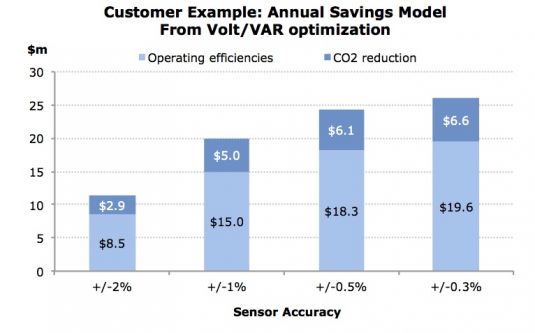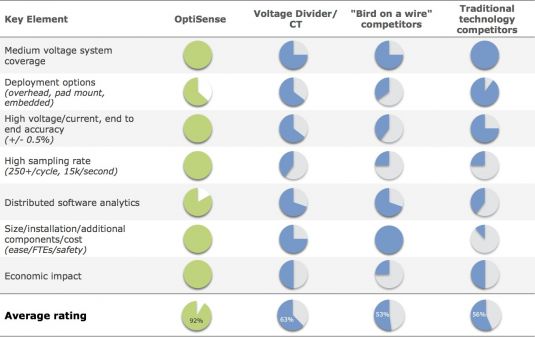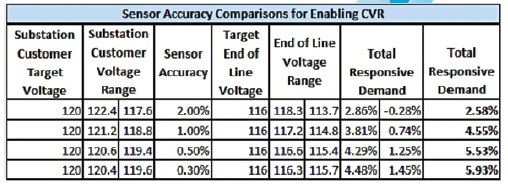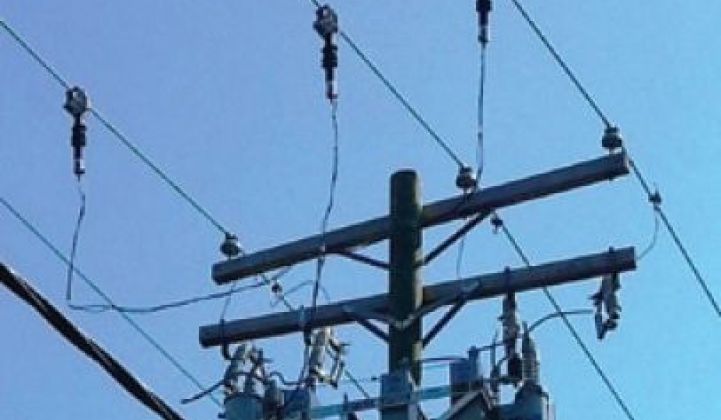When it comes to measuring voltage, current and other grid-power properties, tiny differences in accuracy can add up to a difference of millions of dollars in the value of the smart grid projects they support. The question has always been whether accuracy can be achieved in a reliable form -- and at the right cost.
OptiSense Networks, a startup that’s spent the past twelve years bringing a unique electro-optical sensor technology from laboratory to market, says that its sensors are helping to deliver the benefits of super-high accuracy, at costs that are more than competitive with today’s technologies.
Now, with some multi-year utility projects under its belt and $16 million in private funding raised last year, the Plano, Texas-based startup is getting ready to launch new partnerships with utilities and grid vendors to bring those benefits to a wider audience.
Simply put, OptiSense claims to have “the most accurate sensors for the medium-voltage environment for utilities today,” according to Trey Beasley, vice president of sales and business development. That’s a pretty big claim -- but according to Alabama Power, the Southern Company utility that’s been testing OptiSense’s technology since 2005 as part of EPRI’s Green Circuits program, it’s a claim that's backed up by some real-world evidence.
Take the difference between, say, ±2 percent accuracy and ±0.3 percent accuracy when it comes to measuring voltage. Bridging that accuracy gap is a challenging technical and cost barrier for many sensors aimed at the distribution grid.
But getting to that increased accuracy can more than double the payback on volt/VAR optimization (VVO) and conservation voltage reduction (CVR) schemes in terms of demand response, energy efficiency, deferred capacity upgrades and carbon reductions, as indicated by this chart extrapolating Alabama Power data into annual savings:

This measure of value doesn’t include the extra benefits that OptiSense can provide for more accurate fault location, more accurate modeling for utility distribution management systems, or more accurate measurement of the real-time impacts of distributed generation on the grid, he said. These are among the critical tasks for utilities facing grid-edge challenges, such as managing the bidirectional power flows and voltage disruptions caused by solar PV systems, or tracking the effects of plug-in electric vehicle charging or fast-reacting demand response at the grid’s endpoints.
So how does OptiSense compare to its sensor competitors in terms of cost, complexity and interoperability, and how can larger-scale grid projects take advantage of its features? Here’s an overview, starting with OptiSense's core technology: the use of light to capture grid data.
Turning Light Into Grid Intelligence
OptiSense’s sensors are based on research from the Department of Energy’s Idaho National Laboratory. They're backed up by twelve patents granted, and four more pending patents, covering a range of “electro-optical” technologies. Here’s a quick explanation of how light can be used to measure electricity, excerpted from an article (PDF) by Jon Bickel, vice president of product management for OptiSense:
Light waves are electromagnetic waves that have both electric and magnetic fields that oscillate at right angles to each other. As polarized light is passed through the electromagnetic (EM) fields that surround conductors, it is rotated by an angle that corresponds to the magnitude of the field. The rotation of the polarized light will vary as the EM field varies so that a representative signal can be derived by measuring the degree of rotation as a function of time.
Other technologies out there have used optical technologies to measure current, Beasley told me. But “as far as the method for measuring voltages, we pretty much are the standard on that,” he said.
Likewise, while other existing technologies can yield highly accurate voltage measurements, they’re much larger. Some of them are so big, “it’s like hanging a Volkswagen from the pole,” he said. That means that while they can be slightly less expensive upfront, they end up costing a lot more to install than the “shotgun stick” methods used to install OptiSense sensors, he said.
Other devices, such as line post sensors and voltage dividers, can come in smaller forms that make them cheaper to install. But because these competing technologies are directly manipulating the grid power to get their measurements, they’re limited to lower grid voltages than those that can be measured by OptiSense's technology. What's more, they're susceptible to damage from power spikes that don’t affect optical devices, Beasley added.
As for the long list of lightweight, inductively powered, “hot-stick” installable line sensors from the likes of Sentient Energy, GridSense, Tollgrade Communications and others -- a set of technologies that OptiSense defines as “bird on a wire” systems -- they tend to lack the fine-grained voltage sensing capabilities that OptiSense provides, he said. Here’s the company’s breakdown on how it stacks itself up against its various competitors:

In simple terms, OptiSense’s system sends light through the sensors hung from the power line, he said. As that light travels through the electromagnetic field, it polarizes, and OptiSense measures that polarization at a rate of about 15,000 samples per second to capture voltage and current simultaneously, as well as about 225 different power parameters, he said.
Of course, “Most utilities [are] not getting a stream of 15,000 samples a second -- they’re getting post-processed data for active control,” he said. That’s done via the “OptiProcessor” attached to the utility pole beneath the sensors, which collects, stores, analyzes and condenses the sensor data into information to transmit back to the utility.
“Our OptiProcessor does the nodal processing of all that data, and then provides the root-mean-square processes, the power flows, whether or not something has an event, the harmonics on the system,” he said -- in short, a whole range of valuable grid data. The device’s on-board memory allows each device to retain information for post-event processing as well, which is valuable for a number of tasks, he said.
Turning Optical Insight Into Smarter Grid Systems
On the key issue of managing voltages to save energy, reduce peak loads and delay expensive grid upgrades, accuracy is key to allowing utilities to know just how much room they’ve got to reduce voltages without taking them below minimum operating limits. Every VVO and CVR system out there has to deal with this tradeoff. According to Beasley, “What accurate voltage does is allow you to have a knob you can turn [so] maybe you can be a little bit closer to those thresholds, the lower limit or the upper limit, and know you’re still delivering what you’ve promised to your customers."
“What that becomes is effectively a spinning reserve for demand,” he added. As the following chart shows, the more accurate the sensors, the more “responsive demand” can be squeezed out of the system.

Beyond that, “We can get very good impedance information that can be used to get very good [information about the] location of a fault when it’s tied to the circuit model.” This in turn can be used to direct utility work crews more quickly to downed power lines or to inform fault location, isolation and service restoration (FLISR) systems. Likewise, transient and harmonics analysis could be put to use in monitoring power characteristics that can indicate stress or incipient breakdown of transformers, he said. Eventually, the same data can inform asset management systems and grid operations and maintenance planning, as laid out in this September 2013 article from Electric Energy T&D (PDF).
Finally, “Unlike a lot of technologies out there, this will not require a large IT project to integrate into utilities'" existing systems, Beasley said. “We simply interconnect into a protocol that utilities use,” including the current U.S. standard DNP-3, and by next year, IEC 61850 for SCADA systems and Modbus for backhaul communications, to support work underway with European utilities including France’s EDF and Germany’s E.ON, he added.
OptiSense counts 32 utilities as customers at present, including EDF and E.ON in Europe, Baltimore Gas & Electric, Pepco, Duke Energy, Excel and San Diego Gas & Electric in North America, and Eletrobras in Brazil, Beasley said. While Alabama Power is the furthest along in deploying the technology, two other utilities are in what he described as the “significant rollout phase,” while about half of the remaining are in “targeted” deployments in advance of building business cases for broader rollouts, with the rest in pilot phase.
On the grid vendor partners front, one key partner is Swiss grid giant ABB, which has put the OptiSense technology through a number of tests, including its ability to track power harmonics and transients, as well as its accuracy across operating temperatures from 70 degrees to -40 degrees Celsius (158 degrees to -40 degrees Fahrenheit). Alstom is a partner at Alabama Power, and other DMS vendors are looking at the startup’s capabilities as well, he said.
Beyond that, “We work with a lot of different providers,” he said, including communications providers like Silver Spring Networks, Landis+Gyr, Sensus and AT&T, specialized grid equipment control vendors such as Beckwith and Schweitzer Engineering Laboratories (SEL), and grid software vendors like OSIsoft and Black & Veatch, he said.
OptiSense keeps its financial figures to itself, but news reports note that company co-founders David Welch and Joseph Harlev have invested $1.1 million themselves, and that the state of Texas awarded the company a $1.5 million grant in 2007, prior to its $16 million investment last year. A Dallas Business Journal report from August 2013 that noted that investment also stated that OptiSense reported 2012 revenues of $2.2 million, up from zero in 2010, has invested $1.9 million in its facility and $2.5 million in engineering and R&D, and employed 60 people at its manufacturing plant.
That makes it a small contender against the grid giants out there, and OptiSense has clearly defined itself as a sensor vendor, rather than a competitor in broader grid systems, Beasley said.
“The vast majority of companies we deal with do not see the sensors that they have -- the traditional PTs or CTs or voltage divider-type systems -- as strategic. They see it as necessary, but not something that they want to deliver,” he said. “We are pretty strategic about where we play and where we don’t.”



